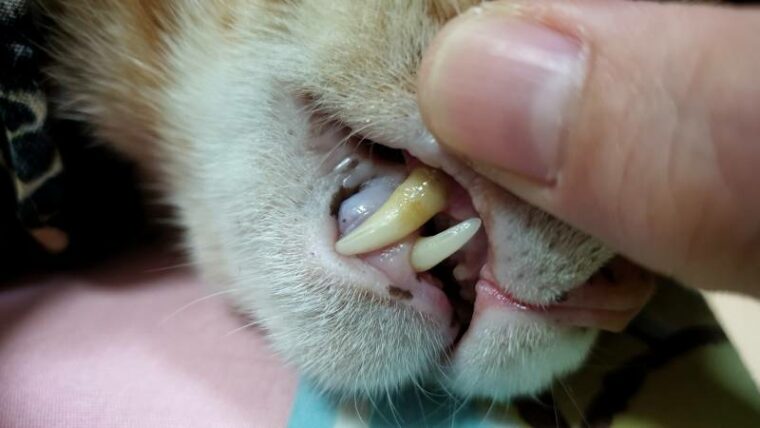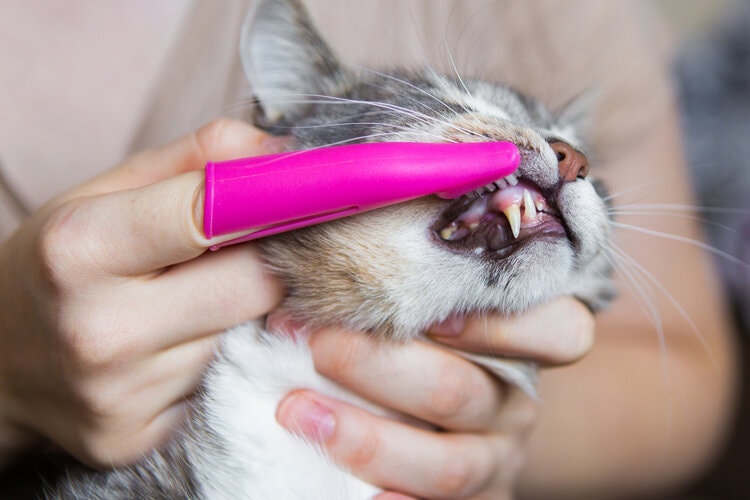
Click to Skip Ahead
Do you know how exactly we all lose our baby teeth? The body undergoes a process called resorption, in which the roots of the baby teeth are eaten away by immune cells until they become loose and can fall out. This type of resorption of a tooth’s root is normal, also known as physiologic.
In many species, but especially cats, there’s something known as pathologic tooth resorption, meaning that it isn’t supposed to be happening. This common disease of elderly cats has several causes and signs, so we have collected everything you need to know about the process to help you.
Components of a Cat’s Tooth
Before we go any further, to follow along with this breakdown of tooth resorption in cats, you’ll want to know some anatomical terms related to teeth.
A cat’s tooth has two regions, above the gum line and below. This border between the two at the gumline is known as the cementoenamel junction (CEJ).
The center of a tooth is called the pulp, and it holds the blood and nerve supply for the tooth.
Surrounding the pulp is a hard, bony-like structure known as dentin. While hard, dentin isn’t as hard as enamel, and it is very sensitive to touch and temperature.
Above the CEJ, dentin is covered by enamel, the hard surface of a tooth that you see when looking into a mouth. Below the CEJ, dentin is covered by cementum, lined by the periodontal ligament. The periodontal ligament attaches the root of the tooth to the underlying bone. The crown of the tooth is the enamel-covered region of the tooth that you can see, the root is the cementum-covered region below the gum line, and the neck is the region of the CEJ at the gum line.

What Is Tooth Resorption in Cats
Tooth resorption (pathologic) is a disease in which the hard parts of the tooth (enamel, cementum, and dentin) are destroyed by the body’s immune system. Destruction of the protective enamel and cementum layers allows dental infections to spread through the dentin into the pulp of the tooth.
Exposure of dentin is painful though most cats will not show outward signs of this. If left untreated, teeth experiencing resorption will be eaten away entirely, crown to root.
Types of Tooth Resorption in Cats
In cats, tooth resorption can be classified into three types.
What Are the Signs of Tooth Resorption in Cats?
In most cases, cats will show no signs of disease until the tooth resorption is already very advanced. We know that dentin exposure is painful, but not all cats will show signs of this that their owner can see. If they do show signs, these are what you might notice:
What Are the Causes of Tooth Resorption in Cats?
The exact cause of tooth resorption in cats is unknown. It seems to be related to inflammation and maybe trauma to a tooth, but a cat’s diet, calcium levels, and FIV status have all been linked to tooth resorption rates in various studies too.
We do know that tooth resorption is far more common in house cats than feral cats, and so something about that lifestyle or the husbandry of house cats seems to be related to the cause.

How is Tooth Resorption in Cats Diagnosed?
If a cat shows signs of resorption, these may be noted by an owner at home or a veterinarian on physical examination. Definitive diagnosis comes from dental X-rays of a cat’s teeth.
Resorptive lesions can be seen on the tooth on dental X-rays or even CT scans when possible, which can then be used to create a treatment plan for the tooth and cat.
How Is Tooth Resorption in Cats Treated?
In most cases, the standard treatment for a tooth with resorptive lesions is to extract the tooth, meaning remove it. In some cases, if the root of the tooth is too eaten away to remove any more, something called a crown amputation can be done, which means removing just the crown of the tooth and covering what’s left with gingival tissue.
How Do I Care for a Cat With Tooth Resorption?
After a veterinarian handles removing initially affected teeth, most cats will still have several teeth left, if not most of them. These cats should be examined every 6–12 months to monitor for future resorptive lesions. Daily dental care, when possible, is also very important for these cats.

Dental Care Product Recommendations for Cats
Cats need regular dental care and upkeep, just like us. For cats developing resorptive lesions, this is even more important.
The best way to prevent future dental disease in a cat is to brush their teeth if they’ll let you. There are numerous brush options to fit any cat mouth, ones with multiple heads to get every side of a tooth brushed at once or ones that allow you to use the tip of your finger to brush their teeth.
Enzymatic toothpaste is the toothpaste type of choice. For help in learning how to brush a cat’s teeth and acclimating them to the process, this is a great resource.
Despite our best efforts, many cats will not tolerate having their teeth brushed regularly. For these cats, the next best option is dental chews.
Dental water additives should never be given to cats without consulting a veterinarian first.
Frequently Asked Questions (FAQs)
How serious is tooth resorption in cats?
Tooth resorption is seen in up to more than half of cats older than 3 and is often painful, but many cats will not show any outward signs that they are sick. That is why it is important your cat receives an annual exam each year and treatment be pursued for tooth resorption if it’s found, regardless of how your cat is acting.
Can cats recover from tooth resorption?
Tooth resorption is a progressive process that will ultimately destroy the entire tooth if not treated. While cases that have made it to that stage no longer need treatment, in all other cases, cats need treatment to recover as the disease is painful. Extraction of teeth with resorptive lesions leaves a cat much more comfortable, though, and they make a great recovery after treatment.
How fast does tooth resorption progress in cats?
Full resorption of a tooth can take many years and it has often been happening for months or years before you notice any signs.
How much does it cost to treat tooth resorption in cats?
Dental extractions, the treatment for tooth resorption, can be expensive. This varies widely based on location, but dentals usually cost a minimum of $600, and extractions are usually additional, costing anywhere from $200–$500 per tooth, which can bring total costs over $2,000 for cats that need most or all teeth extracted. The most commonly affected teeth are a cat’s mandibular premolars, but all teeth can be affected in some cases.
Conclusion
Tooth resorption in cats is a well-understood disease of senior cats, though we aren’t sure exactly what causes it. Unfortunately, since this is a progressive disease process, treatment involves removing any affected teeth and monitoring the remaining teeth in the future. Cats do well after the diseased teeth are removed and continue to live happy, otherwise healthy lives.
Featured Image Credit: RJ22, Shutterstock







